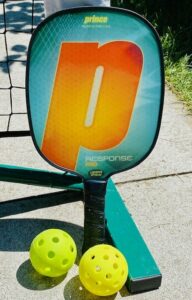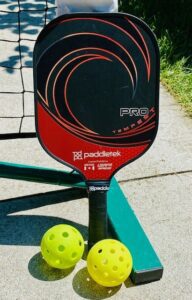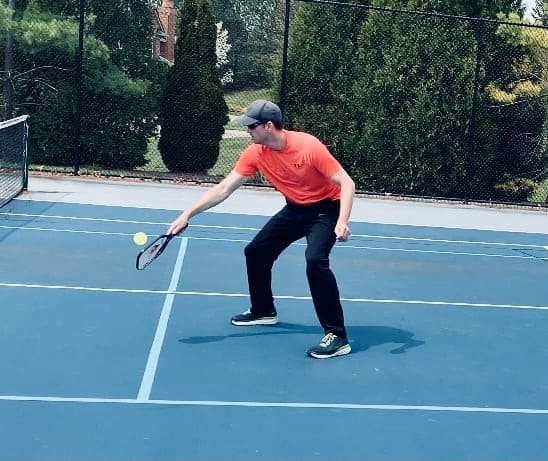Graphite vs Composite Pickleball Paddles – A Helpful Guide For Beginners
Graphite vs composite pickleball paddles. The debate as to which type of paddle is the best has gone on for years now. And it’s only getting stronger as more pickleball paddles come out using either graphite or composite surface materials.
So which one is the best? What are the differences? This is a question I get asked all the time. So, I created this helpful guide to provide a real, honest answer.
So what is the difference between graphite vs composite pickleball paddles? I’ll cover that more in-depth below but the short answer is this – weight and texture. Graphite paddles provide the lightest paddles surface in the game today while Composite paddles are slightly heavier but provide the best textured surface ideal for spin.
In recent years, pickleball has become a wildly popular, world-famous game. It’s similar to tennis in terms of the equipment you need to play: a court, net, pickleball, and of course, pickleball paddles. There are a lot of pickleball paddles available on the market, but it can be difficult to know where to begin.
I’m going to take a look at the differences between a graphite and composite pickle paddle, as well as our top picks for both, so you can make an informed decision on which is right for you.
Editor’s Note: I’ve created three awesome resources for anyone new to the game. If you need to know more about the game of pickleball in general, click the link. Try this one if you wanted to deepen your strategy and wzin more games. And finally, check out why pickleball’s name has been such a source of controversy for decades!
Composite vs Graphite Pickleball Paddles
Here are the main differences between graphite and composite pickleball paddles.
Cost
Let’s be honest, one of the first things that come to mind when we think of making any purchase is how much it costs. When it comes to graphite and composite pickleball paddles, there isn’t much difference in price.
The composite pickleball paddle is technically the cheaper of the two with one at the low end of the range costing roughly $45. A low-end graphite paddle, though, only costs about $60. Neither one is going to cost you more than $145 even at the top end of the range.
Technically, the cost is a very small factor in your decision-making process. That said, if you’re just looking for something cheap to get you going, I have a small list of good composite paddles all in the $50 range. Click here for that.
Now wooden paddles will come in well below the $50 price range. However, keep in mind that wooden paddles don’t give you the same pickleball experience that you could be having with graphite or a composite paddle. I never recommend them.
Material
So, what’s even the difference between the two in terms of material? And most importantly, what are composite and graphite?
Composite

A composite pickleball paddle is made using a variety of materials. They are
“composed” of a hybrid of materials instead of one single material (like graphite).
This mesh and molding approach to combine materials allows composite materials to have a textured surface and can come with any type of paddle core in the middle.
Cores like Polymer, Nomex and Aluminum are most common but polymer cores (in both composite and graphite paddles) are BY FAR the most common because of the response they give players.
The combination of these materials creates a comfortable, foam-like body that is not only easier on the hands, but smoother, softer, quieter and very responsive.
For more helpful info on paddle types and materials check this article out.
In my humble opinion, I prefer composite paddles because of the additional power they provide. They have great “ball grab” ability for putting spin on the ball. Plus, I’ve never felt another paddle respond like the Response Pro (no pun intended) – which also happens to be an elite composite paddle.
Graphite

Graphite paddles generally use the same paddle cores as composite paddles (Polymer, Nomex or Aluminum) but their claim to fame centers around their airy lightweight feel.
Weight
Graphite paddles tend to be lighter than composite paddles. Sometimes by a full ounce or more.
However, generally speaking graphite paddles are going to average around 7.5oz while composite are in the 8.0 ounce range.
But can you actually feel the difference? Yes, many players claim they can feel the lightweight comfort that only graphite paddle can give them.
Aside from the weight of the racquet, many players are attracted to graphite pickleball paddles because when combined with a good honeycomb polymer core, the paddle with give you elite levels of touch and feel.
I’ve felt this with the Tempest Wave and the more expensive Tempest Pro. The racquet almost feels like an extension of your hand, Helping you achieve better accuracy. Where your hand goes, the balls.
Durability
While graphite is generally said to be more durable in terms of face finish, you need to think about both the paddle surface and the core when it comes to which materials are going to last.
Whether or not you choose to go with a paddle face of graphite, composite, plastic, or wood, make sure you choose a face that includes ultraviolet inhibitors to minimize sun damage as well as discoloration.
This gives you the best chance of preserving whichever paddle face you’ve chosen. The key when you’re buying anything, really, is making sure you’re getting value for your money.
Graphite vs Composite Pickleball Paddles – Pros And Cons For Composite
On the pro side, the composite pickleball paddle has more oomph and plow through behind. This is perfect if you’re a power player like am.
Composite paddles are made for power players who like to add spin to their passing shots and rip their serves.
If you tend to take the initiative during a match and dicate the pace of the action. with aggressive shots, you may find yourself gravitating towards a composite pickleball paddle versus a graphite one.
Composite paddles also come in various shapes like “wide body” or “blade” shapes which help meet the requirements of players looking for different things at different skill levels. The textured surface also makes it easier to put good spin on the ball.
Personally I get the most accurate, baseline to baseline power from high-level composite paddles like the Response Pro from Prince. Not that graphite paddles cannot deliver that, I just find that composite paddles deliver this effortlessly.
The main drawback to composite paddles tends to be their level of touch at the net. Getting consistent, soft, accurate dinks at the kitchen line may prove slightly harder with a composite paddle…especially a cheap one.
If you like to dink your opponents to death and lull them to sleep with safe, soft shots that always land in bounds, composite paddles may not give you what your’re looking for.
Graphite vs Composite Pickleball Paddles – Pros And Cons For Graphite
Many professional pickleball players prefer a graphite paddle for a variety of reasons. Although the graphite portion of the paddle is light and rigid, the paddle itself provides exceptional levels of touch and feel.
It really is amazing that even though graphite, as a surface, is more rigid than composite, it actually provides a softer touch.
If you’re a player who likes to win at the kitchen line, and always aim for well placed third shot drops, then I’d steer you towards a top of the line graphite paddle.
Response and feel at the net is something graphite paddles excel at and that’s where its a ton of fun to play with them!
In terms of cons for graphite paddles, their strength can also be their weakness. By that I mean, that lightweight air feel limits these paddles from providing enough power.
I find that composite paddles give me more consistent deep serves and return of serves. Plow through and game winning passing shots can be slightly harder with lighter graphite paddles.
On top of that, it’s also worth noting that there are A TON of graphites paddles on the market for any new player to choose from. This is also a disadvantage because it can very easy to get sucked into a paddle that looks good, touts a high grade graphite paddle face but in the end, isn’t a good paddle.
It’s easy to make a cheap USAPA approved graphite paddle; so buyer beware. Stick to brands like Pro-Lite, Paddletek, Selkirk, Engage, Onix and Prince versus lesser known brands that only sell on Amazon.
Which One Has Better Grip?
When it comes to grip, size is an important factor for making a killer shot. You don’t want a grip that is too big or too small.
One that is too big can cause a player to miss a fantastic shot, while a small grip can be just as uncomfortable, although it does not present the same challenges.
When it comes to graphite versus composite pickleball paddle, though, which grip is better?
The answer is actually neither – both come with the option of small and large-sized grips. It’s worth noting that it’s usually better to use a small-size grip, but that obviously depends on the player.
Pickleball grips are generally only available in large and small, but it’s possible to add an overgrip if needed to make it slightly bigger.
Graphite vs Composite Pickleball Paddles – Conclusion
Now that you know the essentials about graphite and composite pickleball paddles, hopefully you’re closer to figuring out which one is right for you.
When it comes down to it, whether it’s graphite or composite is not the most important factor in picking out your paddle. Each has its benefits and drawbacks, and their differences are only slight.
The bottom line? Buy the paddle that “feels” the best in your hands. While you may already have a specific brand or model in mind, it all comes down to what feels right for your skill level.
If you’re comfortable with your paddle, the game is going to be that much more enjoyable.
Pickleball is quickly gaining in popularity and is a fun activity to pass the time or even grow to play professionally. Take your time and ask questions when picking out your paddle to be sure you get it right!
About Me
I’m just a lover of all sports that involve a racquet, net and a ball. My whole family loves and plays pickleball regularly. I started this website to help give people like you the performance tips and buying info they need to make an educated and informed purchase.
The products I recommend here have been researched, analyzed, compared and in a lot of cases bought, worn and used. If it’s a bad product, I don’t recommend it. Any small purchase made from this site gives me a small commission that helps fund the growth of the site to provide you more helpful information.

Welcome to TheVolleyLlama.com. My name is Keith, I’m just a lover of all sports that involve a racquet, net and a ball. I played competitive high school varsity tennis, love racquetball and my whole family plays pickleball regularly. I started this website to help give people like you the basics to learn these wonderful games.

